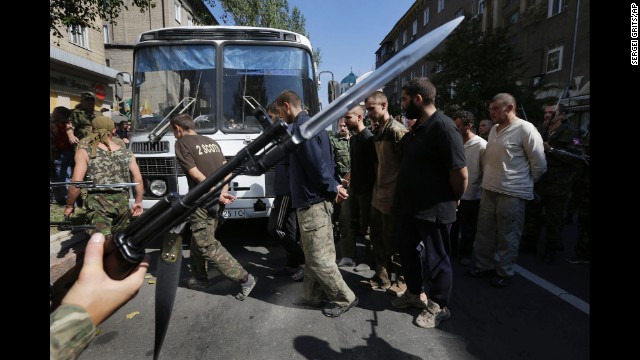 Pro-Russian separatists escort captured Ukrainian army soldiers in a central square in Donetsk, Ukraine, on Sunday, August 24. Ukrainian government forces have been battling pro-Russian rebels near Ukraine's eastern border with Russia. The fighting has left more than 2,000 people dead since mid-April, according to estimates from U.N. officials.
Pro-Russian separatists escort captured Ukrainian army soldiers in a central square in Donetsk, Ukraine, on Sunday, August 24. Ukrainian government forces have been battling pro-Russian rebels near Ukraine's eastern border with Russia. The fighting has left more than 2,000 people dead since mid-April, according to estimates from U.N. officials. 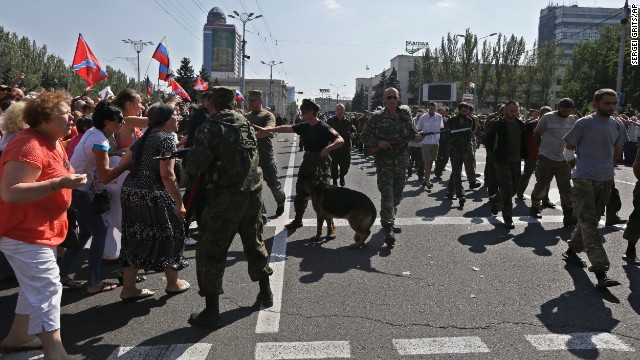 People yell as Ukrainian prisoners are paraded through Donetsk in eastern Ukraine on August 24.
People yell as Ukrainian prisoners are paraded through Donetsk in eastern Ukraine on August 24. 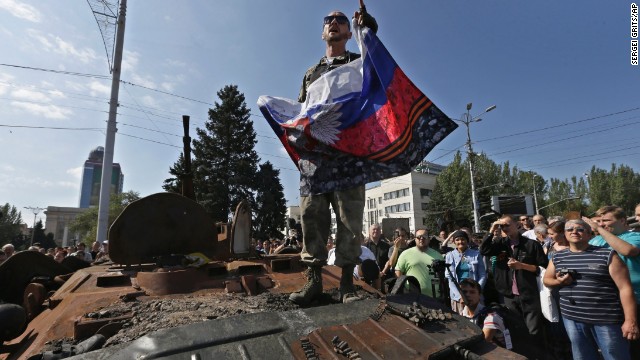 A pro-Russian rebel delivers a speech atop a damaged Ukrainian armored personnel carrier in Donetsk on August 24. Ukraine has recently retaken control of much of its eastern territory bordering Russia, but fierce fighting for the rebel-held cities of Donetsk and Luhansk persists.
A pro-Russian rebel delivers a speech atop a damaged Ukrainian armored personnel carrier in Donetsk on August 24. Ukraine has recently retaken control of much of its eastern territory bordering Russia, but fierce fighting for the rebel-held cities of Donetsk and Luhansk persists. 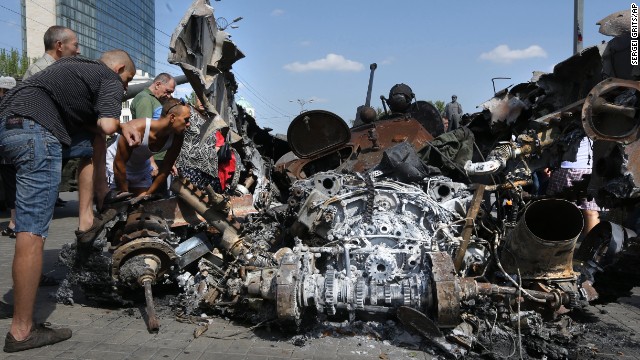 People look at damaged Ukrainian military equipment in Donetsk on August 24.
People look at damaged Ukrainian military equipment in Donetsk on August 24. 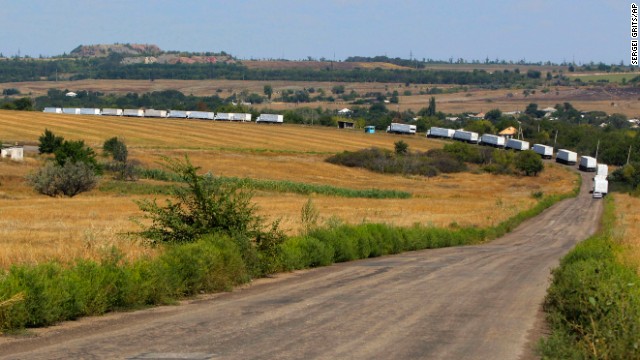 The first trucks of a Russian aid convoy roll on the main road to Luhansk in eastern Ukraine on Friday, August 22. The head of Ukraine's security service called the convoy a "direct invasion" under the guise of humanitarian aid since it entered the country without Red Cross monitors.
The first trucks of a Russian aid convoy roll on the main road to Luhansk in eastern Ukraine on Friday, August 22. The head of Ukraine's security service called the convoy a "direct invasion" under the guise of humanitarian aid since it entered the country without Red Cross monitors. 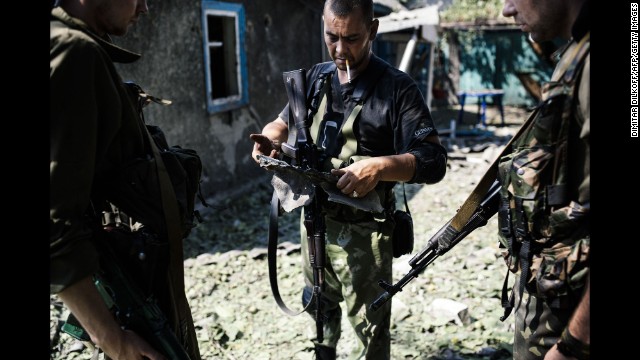 A pro-Russian rebel holds shrapnel from a rocket after shelling in Donetsk, Ukraine, on August 22.
A pro-Russian rebel holds shrapnel from a rocket after shelling in Donetsk, Ukraine, on August 22.  Residents sit in a makeshift bomb shelter during a shelling in Makiyivka, Ukraine, on Wednesday, August 20.
Residents sit in a makeshift bomb shelter during a shelling in Makiyivka, Ukraine, on Wednesday, August 20.  Dogs play together as a Russian convoy carrying aid supplies stops at a border control point with Ukraine, in the Russian town of Donetsk, in the Rostov-on-Don region on August 20.
Dogs play together as a Russian convoy carrying aid supplies stops at a border control point with Ukraine, in the Russian town of Donetsk, in the Rostov-on-Don region on August 20.  Ukrainian forces take their position not far from Luhansk, Ukraine, on August 20. Ukrainian troops made a significant push into rebel-held territory in eastern Ukraine, claiming control over a large part of Luhansk and encircling the largest rebel-held city, Donetsk, in fighting that has left at least 43 dead.
Ukrainian forces take their position not far from Luhansk, Ukraine, on August 20. Ukrainian troops made a significant push into rebel-held territory in eastern Ukraine, claiming control over a large part of Luhansk and encircling the largest rebel-held city, Donetsk, in fighting that has left at least 43 dead. 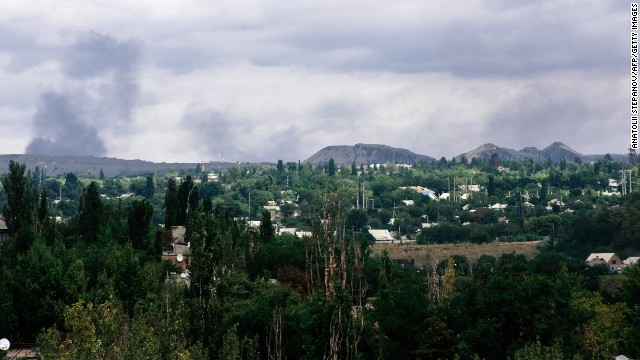 Clouds of smoke are on the horizon as Ukrainian forces and pro-Russian rebels clash in Yasynuvata, a suburb of Donetsk, Ukraine, on Tuesday, August 19.
Clouds of smoke are on the horizon as Ukrainian forces and pro-Russian rebels clash in Yasynuvata, a suburb of Donetsk, Ukraine, on Tuesday, August 19. 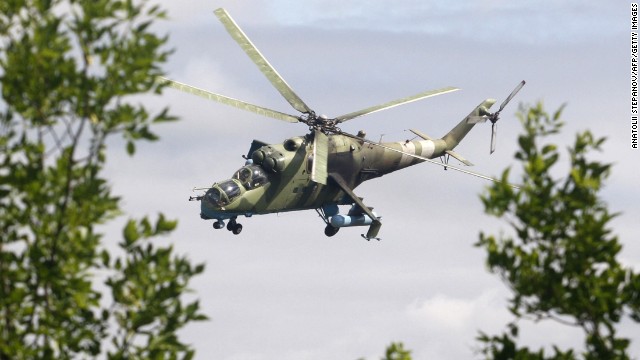 An Ukrainian helicopter flies near Kramatorsk, Ukraine, on August 19.
An Ukrainian helicopter flies near Kramatorsk, Ukraine, on August 19. 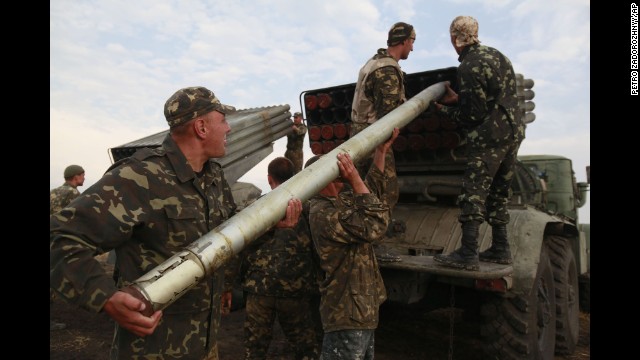 Ukrainian soldiers load a missile during fighting with pro-Russian rebels Monday, August 18, near Luhansk, Ukraine.
Ukrainian soldiers load a missile during fighting with pro-Russian rebels Monday, August 18, near Luhansk, Ukraine. 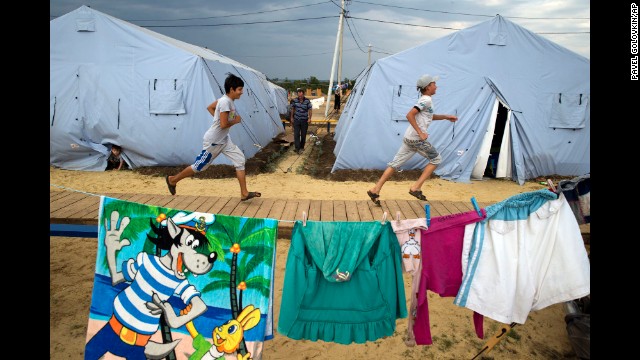 Boys play at a refugee camp, set up by the Russian Emergencies Ministry, near the Russian-Ukrainian border on August 18.
Boys play at a refugee camp, set up by the Russian Emergencies Ministry, near the Russian-Ukrainian border on August 18. 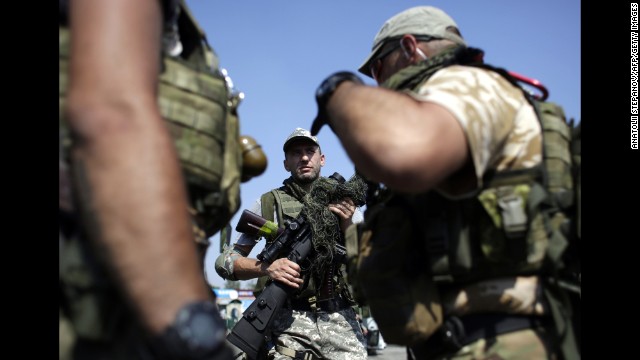 Ukrainian soldiers carry weapons at a checkpoint near Debaltseve, Ukraine, on Saturday, August 16.
Ukrainian soldiers carry weapons at a checkpoint near Debaltseve, Ukraine, on Saturday, August 16. 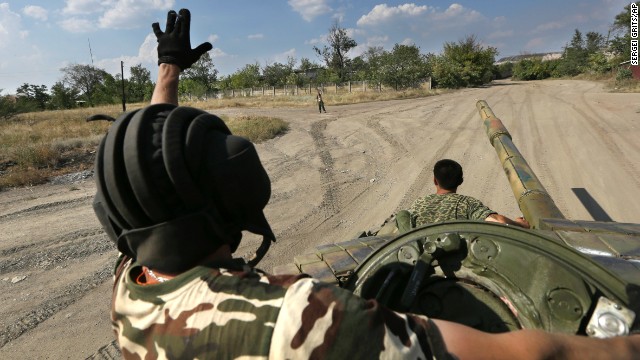 Pro-Russian rebels greet each other as they pass near Krasnodon, Ukraine, on August 16.
Pro-Russian rebels greet each other as they pass near Krasnodon, Ukraine, on August 16. 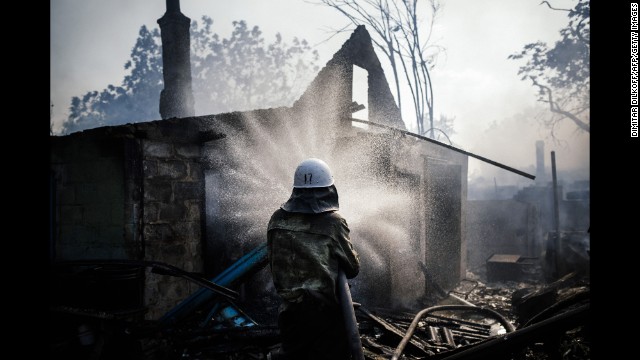 A fireman tries to extinguish a fire after shelling in Donetsk on August 16.
A fireman tries to extinguish a fire after shelling in Donetsk on August 16.  Ukrainian border guards patrol near Novoazovsk, Ukraine, on Friday, August 15.
Ukrainian border guards patrol near Novoazovsk, Ukraine, on Friday, August 15. 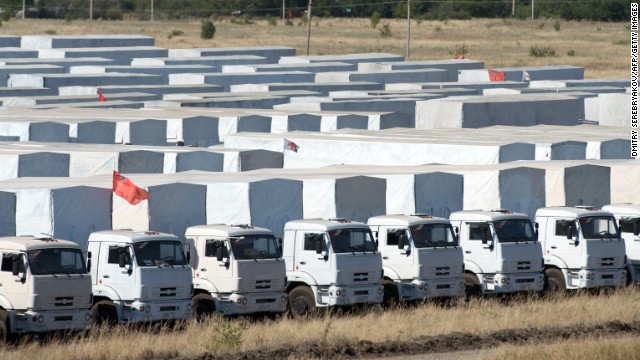 Trucks of a Russian humanitarian convoy are parked in a field outside the town of Kamensk-Shakhtinsky, in the Rostov region of Russia about 20 miles from the Ukraine border, on August 15. Ukrainian officials were preparing to inspect the convoy, which was bound for the conflict-torn east.
Trucks of a Russian humanitarian convoy are parked in a field outside the town of Kamensk-Shakhtinsky, in the Rostov region of Russia about 20 miles from the Ukraine border, on August 15. Ukrainian officials were preparing to inspect the convoy, which was bound for the conflict-torn east.  A truck driver from the convoy jumps out of a trailer on August 15. The Ukrainian government had expressed fears that the convoy was a large-scale effort to smuggle supplies or troops to pro-Russian rebels.
A truck driver from the convoy jumps out of a trailer on August 15. The Ukrainian government had expressed fears that the convoy was a large-scale effort to smuggle supplies or troops to pro-Russian rebels.  A tank belonging to pro-Russian rebels moves along a street in Donetsk on August 15.
A tank belonging to pro-Russian rebels moves along a street in Donetsk on August 15.  A Ukrainian soldier walks past a line of self-propelled guns as a column of military vehicles prepares to head to the front line near Illovaisk, Ukraine, on Thursday, August 14.
A Ukrainian soldier walks past a line of self-propelled guns as a column of military vehicles prepares to head to the front line near Illovaisk, Ukraine, on Thursday, August 14.  A Ukrainian soldier prepares a mortar at a position near Illovaisk on August 14.
A Ukrainian soldier prepares a mortar at a position near Illovaisk on August 14. 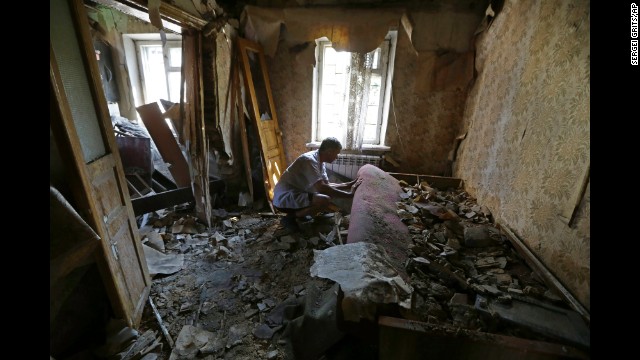 A man inspects damage at his house after a shelling in Donetsk on August 14.
A man inspects damage at his house after a shelling in Donetsk on August 14. 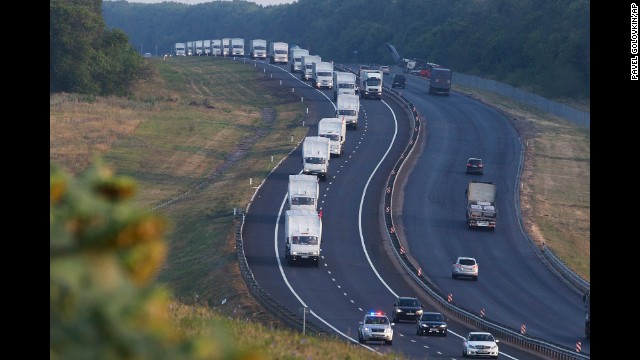 A convoy of trucks, which Moscow said was carrying relief goods for war-weary civilians, moves from Voronezh, Russia, toward Rostov-on-Don, Russia, on August 14.
A convoy of trucks, which Moscow said was carrying relief goods for war-weary civilians, moves from Voronezh, Russia, toward Rostov-on-Don, Russia, on August 14. 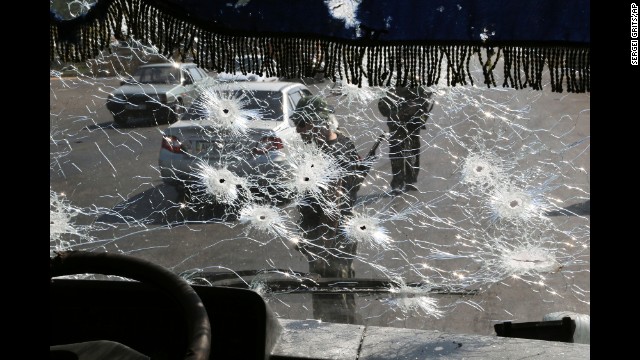 Pro-Russian rebels on the outskirts of Donetsk stand at a checkpoint near a bullet-riddled bus on Wednesday, August 13.
Pro-Russian rebels on the outskirts of Donetsk stand at a checkpoint near a bullet-riddled bus on Wednesday, August 13.  A pro-Russian rebel inspects damage after shelling in Donetsk on Thursday, August 7.
A pro-Russian rebel inspects damage after shelling in Donetsk on Thursday, August 7. 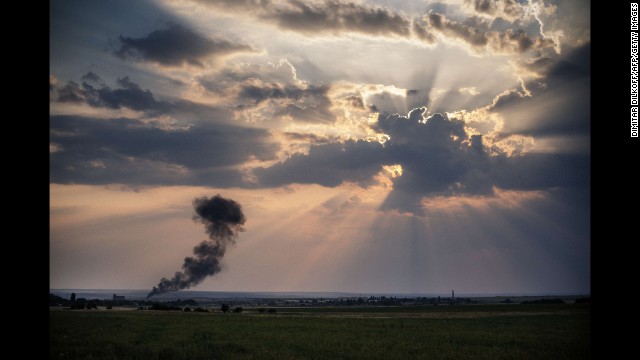 Smoke billows from a Ukrainian fighter jet crash near the village of Zhdanivka, Ukraine, on August 7.
Smoke billows from a Ukrainian fighter jet crash near the village of Zhdanivka, Ukraine, on August 7. 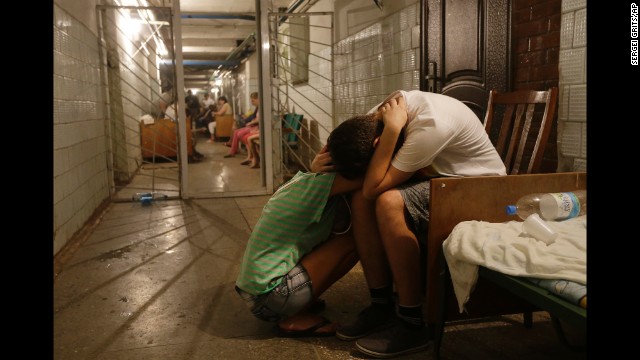 Residents of eastern Ukraine cry in a hospital basement being used as a bomb shelter August 7 in Donetsk.
Residents of eastern Ukraine cry in a hospital basement being used as a bomb shelter August 7 in Donetsk. 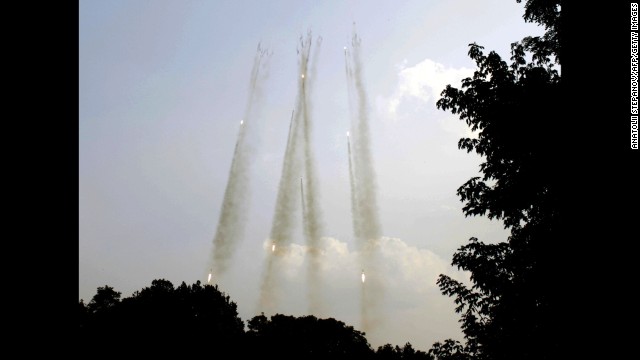 Ordnance from a Ukrainian rocket launcher shoots toward a pro-Russian militant position in the Donetsk region on August 7.
Ordnance from a Ukrainian rocket launcher shoots toward a pro-Russian militant position in the Donetsk region on August 7. 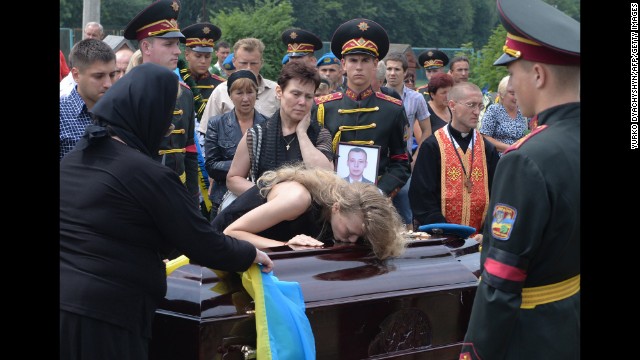 Relatives of Ukrainian military member Kyril Andrienko, who died in combat in eastern Ukraine, gather during his funeral in Lviv, Ukraine, on August 7.
Relatives of Ukrainian military member Kyril Andrienko, who died in combat in eastern Ukraine, gather during his funeral in Lviv, Ukraine, on August 7. 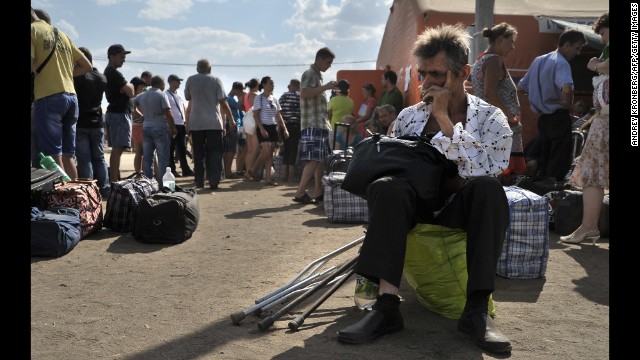 Refugees from southeastern Ukraine wait at a refugee camp in Donetsk on Wednesday, August 6.
Refugees from southeastern Ukraine wait at a refugee camp in Donetsk on Wednesday, August 6. 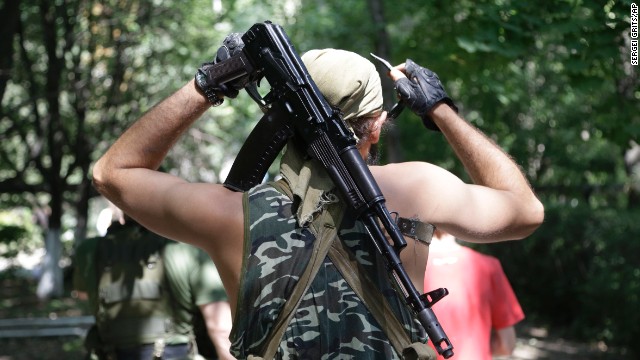 A pro-Russian rebel adjusts his weapon in Donetsk on August 6.
A pro-Russian rebel adjusts his weapon in Donetsk on August 6.  Men walk past a bomb crater in Donetsk on August 6.
Men walk past a bomb crater in Donetsk on August 6.  A man steps out of his car as Ukrainian soldiers inspect the vehicle at a checkpoint in Debaltseve on August 6.
A man steps out of his car as Ukrainian soldiers inspect the vehicle at a checkpoint in Debaltseve on August 6. 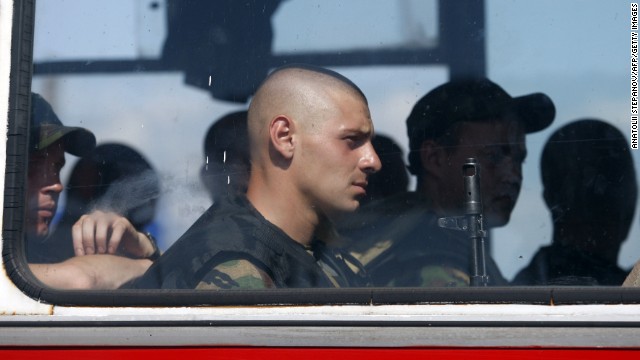 Ukrainian servicemen sit on a bus near Slovyansk, Ukraine, on Tuesday, August 5.
Ukrainian servicemen sit on a bus near Slovyansk, Ukraine, on Tuesday, August 5.  A pro-Russian separatist guards a road as Australian, Malaysian and Dutch investigators prepare to examine the crash site of Malaysia Airlines Flight 17 near the village of Rossipne, Ukraine, on August 5. U.S. and Ukrainian officials allege that a Russian-made missile shot down the plane from rebel-held territory, killing all 298 people on board. Russia and the rebel fighters deny involvement.
A pro-Russian separatist guards a road as Australian, Malaysian and Dutch investigators prepare to examine the crash site of Malaysia Airlines Flight 17 near the village of Rossipne, Ukraine, on August 5. U.S. and Ukrainian officials allege that a Russian-made missile shot down the plane from rebel-held territory, killing all 298 people on board. Russia and the rebel fighters deny involvement. 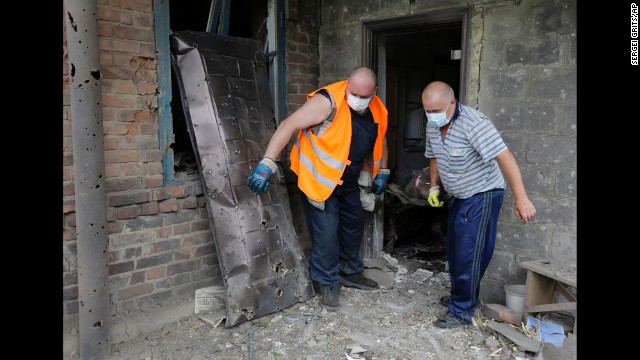 Rescue workers carry the body of a woman who was killed during a bomb shelling in Donetsk on August 5.
Rescue workers carry the body of a woman who was killed during a bomb shelling in Donetsk on August 5. 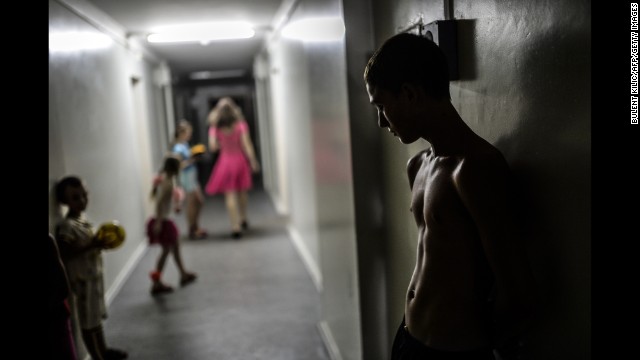 A boy stands in a hallway of a refugee hostel run by pro-Russian rebels in Donetsk on Monday, August 4.
A boy stands in a hallway of a refugee hostel run by pro-Russian rebels in Donetsk on Monday, August 4.  Ukrainian servicemen from the Donbass volunteer battalion clean their guns Sunday, August 3, in Popasna, Ukraine.
Ukrainian servicemen from the Donbass volunteer battalion clean their guns Sunday, August 3, in Popasna, Ukraine. 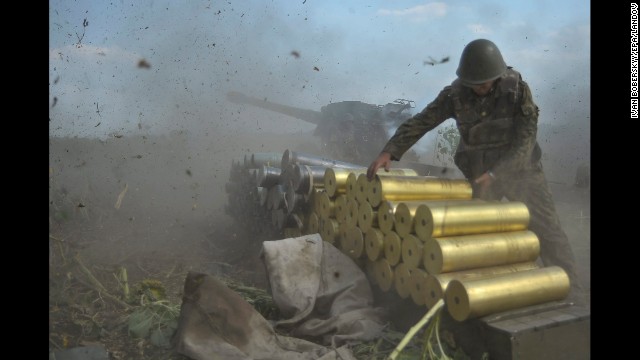 Ukrainian soldiers fire shells toward rebel positions near Pervomaysk, Ukraine, on Saturday, August 2.
Ukrainian soldiers fire shells toward rebel positions near Pervomaysk, Ukraine, on Saturday, August 2.  Ukrainian troops patrol near the village of Novoselovka on Thursday, July 31.
Ukrainian troops patrol near the village of Novoselovka on Thursday, July 31. 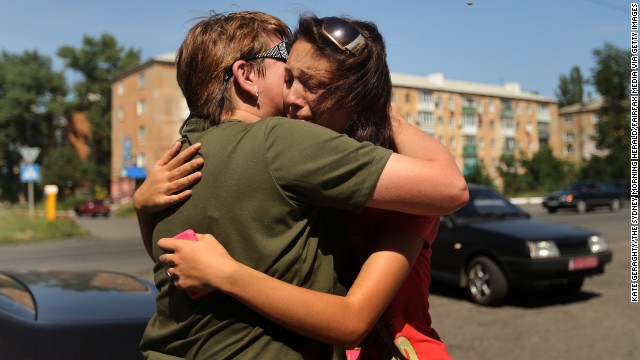 A woman says goodbye to her mother as she flees her home in Shakhtersk, Ukraine, on Tuesday, July 29. See more photos of the crisis from earlier this year
A woman says goodbye to her mother as she flees her home in Shakhtersk, Ukraine, on Tuesday, July 29. See more photos of the crisis from earlier this year
- The Ukraine conflict started with a dispute over a trade deal
- That ballooned into protests, then Russia stepped in
- Looking forward, an outright invasion seems unlikely, analysts say
- It won't be easy to unravel the complex political and economic forces tugging at Ukraine
(CNN) -- More than 2,000 lives lost. A vast and unfolding humanitarian crisis. And the downing of a civilian airliner that shocked the world.
It's hard to imagine -- but true -- that the raging conflict between Ukraine and Russia, or at least Ukraine and pro-Russian rebels, all started with a humble trade agreement.
As tensions run high over a Russian aid convoy described by Western leaders as a provocative incursion, reports of direct Russian military activity inside Ukraine and Ukrainian fears of an outright invasion, it's time to look back on how we got here, and where things are headed:
 Ukrainians fight to survive amid siege
Ukrainians fight to survive amid siege  Questions return with Russian convoy
Questions return with Russian convoy How it started
While the roots of the crisis run quite deep, what's happening now began to unfold in earnest in the fall of 2013.
That's when then-Ukrainian President Viktor Yanukovych scuttled a trade deal with the European Union that would have pulled the country, so recently a satellite of the Soviet Union, toward Europe in the latest twirl of a dance that has lasted centuries.
Instead, Yanukovych jumped at Russian President Vladimir Putin's offer to buy $15 billion in debt from his cash-strapped government and cut the price of vital natural gas to the country.
Yanukovych's decision set off protests in Ukraine's more Europe-leaning west calling for the government's ouster. Security forces responded harshly, beating protesters and firing live ammunition into demonstrations, resulting in several deaths. As clashes spread, so did international anger over the situation.
By late February, Yanukovych had fled to Russia, the government had fallen and a new pro-Europe government had formed to replace it.
That, in turn, set off pro-Russian demonstrations in Crimea, a semi-autonomous Ukrainian republic and the location of a major Russian navy base.
After thousands of Russian troops filtered into the territory -- purportedly at the invitation of Ukraine's self-exiled president -- Ukraine's regional parliament called a referendum on secession, and before you could say "borscht," Crimea was part of Russia.
And it's here that things turned even uglier. Pro-Russian fighters occupied government buildings in the country's east, demanding a referendum on independence.
Before long, rebel forces -- believed to be supported by Russia -- had taken control of major cities in Ukraine's east. Fighting broke out between the rebel groups and Ukraine's military, fighting that continues today.
In a major and likely inadvertent escalation in July, a suspected surface-to-air missile believed to have been operated by pro-Russian rebels shot down Malaysia Airlines Flight 17, killing all 298 people aboard and hardening Western opinion, particularly in Europe, against Russia.
What's happening now
Ukraine's military has been on the offensive recently against the pro-Russian forces, but those successes seem to have slowed.
Russian troops remain camped along the Ukrainian border, Western leaders say.
And Ukrainian officials said Tuesday that they had detained 10 Russian soldiers in the Donetsk region of eastern Ukraine, further evidence, Kiev says, of direct Russian involvement in the conflict.
Meanwhile, the United Nations has warned of a growing humanitarian crisis sure only to get worse unless something is done to stem the fighting.
What's next
A full-scale invasion is unlikely. While Putin's approval rating among Russians is sky-high, recent polling shows the Russian people aren't wild about an out-and-out invasion of Ukraine, said Robert D. Kaplan, the chief geopolitical analyst for Stratfor. "He may be a dictator, but dictators care about public opinion as much as democrats," he said.
But any talk of peace from Putin is likely a stalling tactic. Putin is buying time so that he can continue slipping arms and aid to help rebels recover from their recent losses, said Heather Conley, senior vice president of Europe and Eurasia at the Center for Strategic and International Studies. "His best option is to have a permanent frozen conflict," she said.
Fall and winter will slow the fighting. Kaplan said the colder seasons in Ukraine mean mud and mud means a slower tempo for military operations. Just don't expect total silence, he says -- there will still be fighting.
Moscow will try to squeeze Ukraine. Putin will slow the flow of crucial natural gas and goods into Ukraine, putting further pressure on Kiev's economy and war-fighting ability. "The Russians will try everything to weaken the regime in Kiev," Kaplan said.
The West has some soul-searching to do. Sanctions applied by the United States and Europe against Russia have so far only played into Putin's playbook, enhancing the image of an aggrieved Russia trying to shake off its detractors, Conley said. Putin's strategy of assembling a larger Russian empire has significant ramifications for Estonia and Latvia, Conley said, raising questions about just what the West will do to stop Russia if Putin chooses to further extend his reach.
And what will it take to end this? Ukraine is a linchpin of Putin's plans for Russia, whether it's reassembling a historical empire or shoring up the Russian economy, Conley says. So whatever happens must support that. Kaplan says Putin can't pull back without gaining assurances that Ukraine will never become part of NATO. Ukraine, he said, needs assurances about its sovereignty and energy security.

0 comments:
Post a Comment